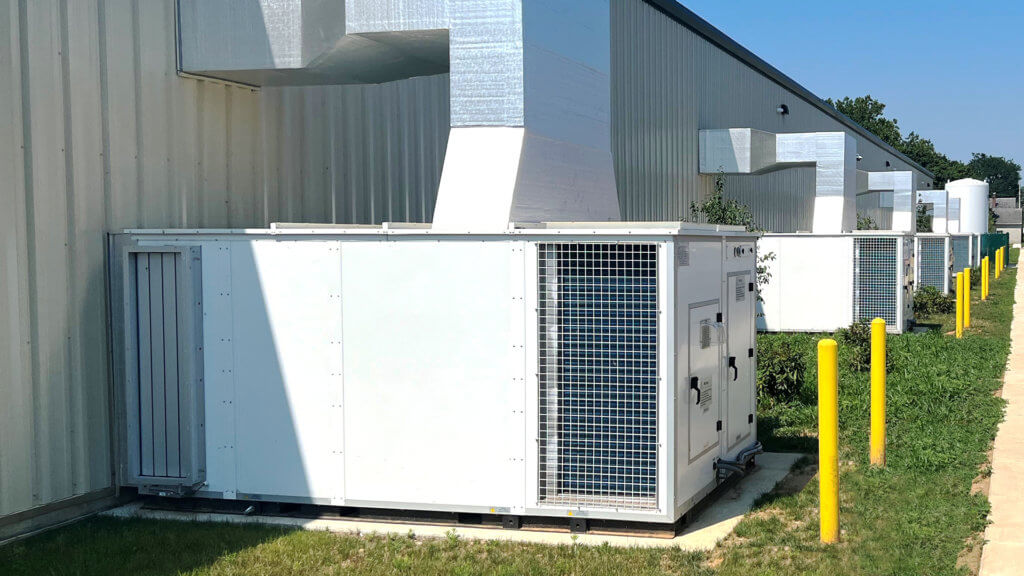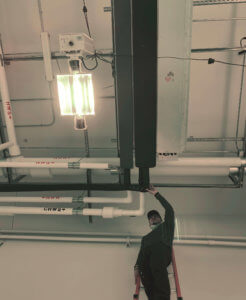Your HVAC system plays a critical role in your ability to cultivate healthy crops in a controlled environment. The mechanical equipment that control the temperature and humidity of your grow rooms require regular maintenance just as any piece of machinery does. We change the air filters in our home furnaces, we change the oil in our cars, and we must also service commercial HVAC equipment to keep it operating at peak performance.
What Does a Grow Room HVAC Maintenance Plan Include?
Every system is unique. Your maintenance needs should be informed by the criteria of your specific equipment, seasonal factors, and your grow methodology.
Some maintenance is straight forward and can be easily implemented internally. However, hiring a licensed technician to perform routine preventative maintenance on more complex systems can help mitigate expensive and stressful HVAC-related emergencies. Talk to your mechanical engineer about what your system will require and put a maintenance plan in place prior to installation.
While every system’s requirements are unique, typical HVAC preventative maintenance will include:
- Cleaning: Cleaning coil surfaces, fan impellers, electrical contacts, burners, pilot and igniter, cooling tower baffles, basin, sump
- Calibrating: Temperature controls, safety controls, and pressure controls
- Tightening: All electrical connections, mounting bolts, refrigerant pipe fitting, hose clamps, damper assembly
- Adjusting: Belt tension, refrigerant charge, super heat, fan RPM, gas pressure, the controls set points, unloaders, damper linkages, fan inlet guide vane
- Aligning: Drive assemblies, belts, couplings, air fins
- Lubricating: Motors, damper bearings, fan bearings, valve stems, damper linkages, fan vane linkages

How Often Should You Have Your HVAC Equipment Serviced?
To ensure optimal performance, your HVAC equipment should be serviced every 3-months. Waiting too long between inspections could lead to dirty filters, clogged drains, performance deterioration, damage to the unit, or even equipment failure. Regular services keep your equipment clean and running smoothly.
Facility Maintenance
You may have heard the term “facility maintenance plans,” (or FMPs for short). FMPs typically includes tasks related to keeping your grow room clean and operational. This could include cleaning components like the air filters, checking the fans, maintaining lighting fixtures, inspecting plumbing systems, evaluating water filtration, servicing mechanical systems, and other similar tasks. Your HVAC maintenance plays a big part of your overall FMP.
Why Invest in An HVAC Maintenance Plan?
There are many benefits to having a maintenance plan for your grow room. Some of the biggest ones are:
- Extend the life of your equipment
- Maximize performance
- Reduce energy costs
- Minimize the risk of costly repairs and downtime
1. Extend the Life of Your Equipment

Commercial HVAC equipment is more complex than residential units. Furthermore, with the substantial cooling and dehumidification requirements of indoor agriculture, your HVAC system will need to be powerful and precise. In order to get the longest life out of your equipment, you will need proper design and adequate maintenance.
Engaging a mechanical engineer with experience in controlled environment agriculture (CEA) is vital to the success of your climate system. Designers without expertise in this application may unintentionally deliver plans that do not account for the unique challenges that a grow room presents. For instance, your engineer must take into account watering volumes and rates, lighting schedules, racking layouts and cultivation tiers, and more when performing load calculations. An under-engineered system will need to work harder to meet your setpoints, which will wear it out faster and increase the likelihood of experiencing mechanical failures.
Even if your system has been properly sized, failure to maintain it will also diminish its longevity. If you are investing in a unit with a 20-year life expectancy, you will wish you’d maintained it if it fails after just ten, as any money you may have saved in maintenance will not outweigh the cost to replace the unit prematurely. To extend the life of your equipment, your HVAC maintenance plan should ensure your system is inspected regularly by licensed technicians to perform the aforementioned list of duties.
2. Maximize Performance

There are a number of issues that can arise from inadequate HVAC maintenance that can cause your equipment to work harder and fail to perform as intended. A common example is that of dirty air filters. If you do not regularly replace your air filters, the debris will continue to build up, blocking air from passing through. Now imagine this neglect on a commercial scale in which many air filters are clogged and affecting airflow. The system will need to work harder to intake air for conditioning, and may not be able to cool or dehumidify as much as it is meant to.
Regular preventative maintenance can keep your climate control system at peak-performance. This is especially necessary for indoor grow room applications in which failing to meet climate setpoints can be disastrous for harvests.
3. Reduce Energy Costs

This is perhaps the most obviously appealing reason to implement an HVAC maintenance plan since every business owner wants to save money and be as energy efficient as possible. A unit that must work harder and run longer due to poor maintenance will drive up your energy bill. In fact, it is typical for your heating, cooling, ventilation, and dehumidification to account for a third of a grower’s operational costs. This places great importance on protecting your energy efficiency.
Implementing a comprehensive HVAC maintenance plan is a straightforward way to protect your investment and maximize energy savings.
4. Minimize the Risk of Costly Repairs and Downtime

Regular inspections and maintenance help keep your HVAC system running smoothly. By catching potential issues proactively, you can minimize the risk of equipment failure which could be a very expensive problem to face. Prolonged downtime can lead to disastrous results including the decimation of entire harvests. Even if you have an HVAC system designed with redundancy, the other units will need to work harder to compensate. Not only this, but emergency calls are very expensive. The best course of action is to be proactive, not reactive.
Full-Service Cultivation Facility Design and Maintenance
Cultivation facilities that include maintenance staff as part of their personnel team should ensure they are familiar with the equipment that will be installed so that they may service them properly. Find out if they will require training from the system provider prior to commissioning.
Those without a maintenance crew on staff can opt to contract with a provider like Surna who will send a technician on a regular basis to tend to your mechanical equipment. We work with an extended network of licensed technicians to provide on-site support and regular preventative maintenance.

Every HVAC preventative maintenance plan is catered to your specific system’s needs so that you can grow with confidence in your environmental control even after commissioning has been completed. Typical plans include four quarterly site visits for system inspections and tune-ups. Considering investing in an HVAC maintenance plan for your commercial grow facility? Contact us to learn more about your options.

